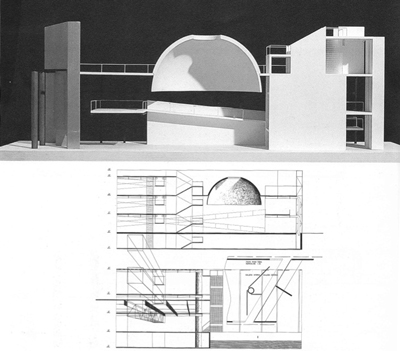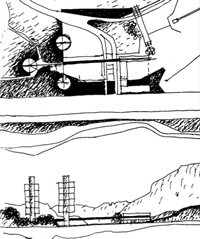You are in: Home page > Magazine Archive > Gianugo Polesello. The art of winning respect

Franca Caberletti
Gianugo Polesello. The art of winning respect

Gianugo Polesello, Project for the Italian Pavilion at the Biennial Gardens, Venice 1987
“Honour is the opinion others have of us, i.e. the general opinion of those who know of us; more precisely it is the general opinion that those who know us have of our value under a certain aspect which must be taken into serious consideration, and which determines the various kinds of honour. In this sense honour can be defined as the representative of our value in the thoughts of others.” Arthur Schopenhauer
The exhibition Gianugo Polesello. Master of the Indecipherable Venetian Self-portraits marries Polesello’s “Venetian” projects with the self-portraits of his last years of life highlighting how much more “indecipherable” his work becomes if separated from the man. Polesello draws himself in plan and elevation as if he were one of his pieces of architecture, confirming, also in the self-portrait, that the plan/elevation is the generatrix of the project. Personally I remembered the figure of Polesello through the relationship established over my degree thesis “The astronomical observatory, the remote control station: an architectural project”, supervisors Gianugo Polesello, Armando Dal Fabbro and Carmelo Majorana. Polesello invited me right away to tackle the theme of the astronomical observatory beginning from its origins, searching history for the evolution of the architectural type and the central plan correlated to its specific function. During the maturing of the project the repeated invitation was to eliminate everything superfluous leaving in the plan/elevation, only the most essential elements. Polesello’s approach was that also more complex engineering and technological themes and aspects could be translated into an architectural project. The reminders of his own projects were relentless: above all the Ravascletto cable car for Mount Zoncolan in 1972 and the Accademia bridge in Venice of 1985. Being near him I understood that Alberti’s definition of “beauty” perfectly fit his concept of architecture, namely of “concinnitas, harmony among all the parts, in the unity they form part of, founded on top of a precise law, in a way that it becomes impossible to add or remove or change anything, unless for the worst”. In Polesello’s works, the concinnitas between all the parts can be felt, all the parts that make it up. The parts make up the project through mathematical and geometrical rules. The Cartesian reticule of the geometric/structural fabric with 7.5 metre steps, adopted in the plan and elevation defines the very proportions of his architecture. Polesello’s architecture aims to conserve the pure form of the geometrical figures that make it up; the isosceles triangle, the square, the circle, the prism, the cube, the parallelepiped, the cylinder. Polesello removes ornament from his architecture, since he considers it “pulcritudo addita”, an “accessory attribute, a non-indispensable adjunct”. Polesello’s architectural works are therefore immediately structure, right from the sketch, right from the moment of the conception of the very idea of architecture. His architecture is abstracted to the extent that it becomes a static/structural, and at the same time functional scheme. Particularly in his Indian ink sketches Polesello leaves on the sheet the traces and the weight of the very structure of the piece of architecture: certain lines are greatly incised and thickened, these are the imprints of considered architecture. There are clear reminders of trilithon classical architecture, with architraves, where the vertical supports are represented by the column and the horizontal ones by the architrave. Classical architecture is the matrix of his thinking and is so interiorized that the architectural elements extrapolated from the history of architecture have been assembled and re-composed ironically within the project in a non-canonical way, the elements evoke a classic world that remains the symbol of a way of proceeding and thinking. Suffice to think of the cupola suspended over the project for the Italian pavilion or the columns of the entrance portico in the project for the Offices of the Italian House of Commons. In his sketches, Polesello instantly defines the constituent elements of the project, the spatial reticule, the plan, the vertical elements (the columns, pillars, walls,) and the horizontal elements (the architraves, trusses, slab floors, reticular roofing, walkways); the (fixed) load-bearing elements are quite distinct from the (mobile) plugging ones, the opaque parts from the transparent ones. In many projects, Polesello adopts a framework structure; the horizontal supports (beams) and vertical (pillars) or points (columns) swap places from time to time according to the limits imposed and on the basis of the type of join envisaged. He was to study frameworks in concrete, steel, and mixed materials. The materials are important. Suffice to think of the uniformity of the white granite that makes up the blind perimeter wall of the parliament offices (Rome 1966), or the wall of sheet steel in his second project for the Museum of the Resistance in the San Sabba rice mill (Trieste 1966-68), two walls of sheet steel with an armature in sections, stiffened transversely by a series of shaped diaphragms 15 metres high. His thinking is in line with Mies and Le Corbusier. In his projects the structures are assembled jigsaw-style with a nod to the construction techniques of his times: elements prefabricated, and mounted and assembled on site. Polesello makes use of structural elements that are easily erected to create complex works of architecture in terms of space, the control of natural light and the articulation of their functions and thoroughfares.
Franca Caberletti worked with Gianugo Polesello.

G. Polesello, study sketch for the Zoncolan tourist centre in central Carnia, 1968














